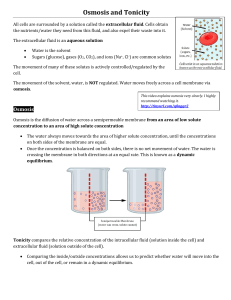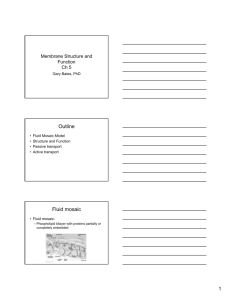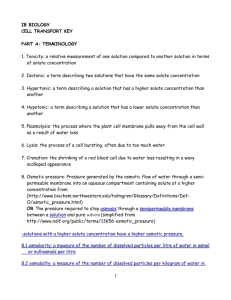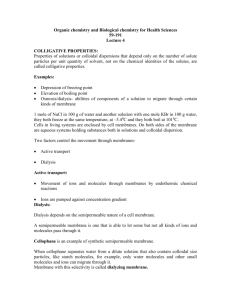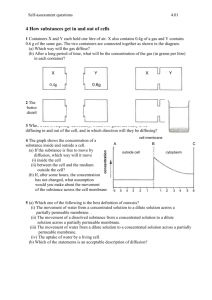OSMOSIS (A self-instructional package)
advertisement
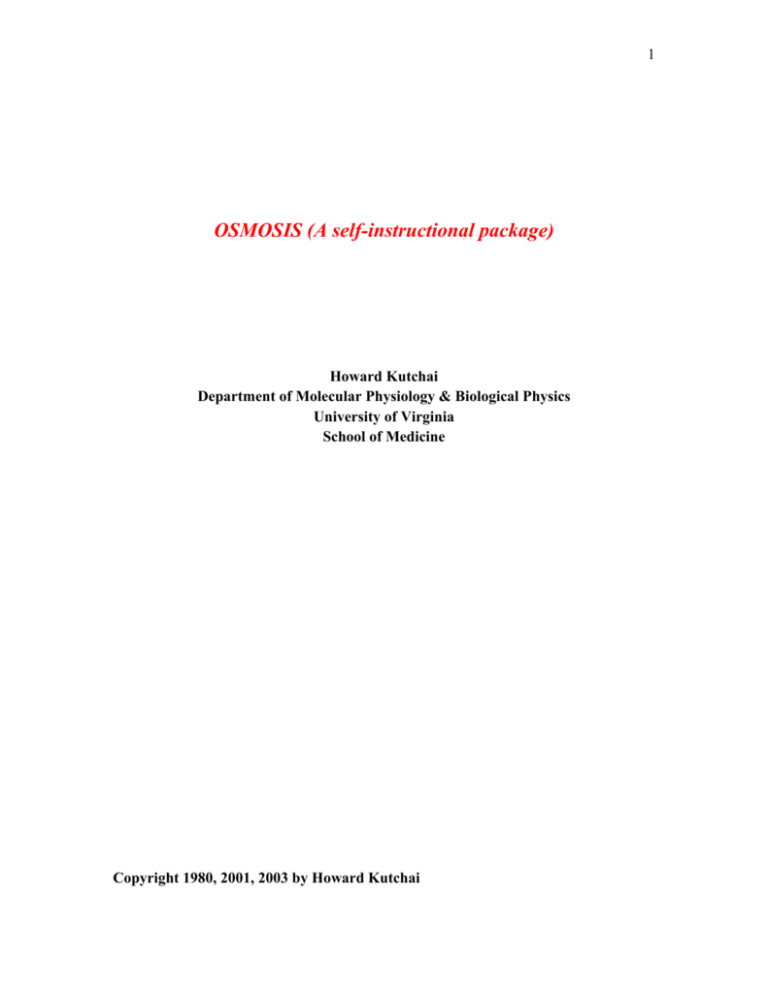
1 OSMOSIS (A self-instructional package) Howard Kutchai Department of Molecular Physiology & Biological Physics University of Virginia School of Medicine Copyright 1980, 2001, 2003 by Howard Kutchai 2 OBJECTIVES 1. Define osmosis, osmotic pressure, and ideal semipermeable membrane. 2. Write van't Hoff's Law (π = iRTc) and use this equation to estimate the osmotic pressure of a solution. State that van't Hoff's Law applies exactly only to very dilute solutions. 3. State that the osmotic coefficient (Φ) is used to correct for deviations of real solutions from the predictions of van't Hoff's Law (ideal solution theory). Given values for Φ, use π = ΦiRTc to calculate the osmotic pressure of a solution. 4. State that the osmotic pressure of biological solutions is usually estimated from their freezing point depression. State that the effective osmotic concentration (ΦiC) in osmoles/liter is computed as ∆Tf/1.86, where ∆Tf is the freezing point depression in oC. 5. State that 154 mM NaCl is isotonic to human erythrocytes (red blood cells) and that this means that in 154 mM NaCl red blood cells will have the same volume they have in plasma. State that red blood cells will swell in hypotonic NaCl (solutions more dilute than 154 mM) and that red cells will shrink in hypertonic NaCl (solutions more concentrated than 154 mM). Compute the steady-state volumes achieved by red blood cells in NaCl solutions of different concentrations. 6. State that the volume flow (Jv) through a membrane caused by an osmotic pressure difference (∆π) due to a concentration difference of a completely impermeable solute is Jv = Lp∆π, where Lp is the hydraulic conductivity of the membrane. Use this equation appropriately to calculate Jv. 7. State that solutes that are somewhat permeable to a membrane induce smaller osmotic volume flows than impermeable solutes. State that for permeable solutes Jv = σLp∆π.,where σ (sigma) is called the reflection coefficient of the membrane for the solute in question. State that the reflection coefficient is equal to 1 for impermeable solutes and approaches zero as solutes become more and more permeable. Use this equation under appropriate conditions to calculate Jv. 3 PRACTICE CYCLE 1 INPUT 1 Consider the situation diagrammed below. A 1M solution of sucrose is separated from a chamber containing pure water by a membrane which is permeable to water, but impermeable to sucrose. Water will flow across the membrane from chamber B to chamber A. This process is known as osmosis. The solute (sucrose) has the effect of lowering the effective concentration of water molecules, or more properly lowering the chemical activity of water, and this may be thought of as the driving force for osmosis. In this example osmosis will continue until chamber B is empty. Had we begun with a less concentrated sucrose solution in chamber B, say 0.5M, instead of pure water, water would still flow by osmosis from chamber B to chamber A. As this occurred, the sucrose in A would be diluted, while that in B became more concentrated. When the sucrose concentrations in A and B are exactly equal, osmosis will cease. Water will be in equilibrium between A and B. Since the membrane is permeable to water, but impermeable to sucrose, the membrane is called semipermeable. An ideal semipermeable membrane is permeable to water, but completely impermeable to all solutes. (No such membrane actually exists.) 4 PRACTICE 1 Define (a) Osmosis (b) Ideal semipermeable membrane FEEDBACK 1 Were your definitions something like this? (a) Osmosis: The movement of water from a solution in which solute is less concentrated to a solution in which solute is more concentrated through a membrane that is permeable to water but impermeable to solute. (b) Ideal semipermeable membrane: A membrane that is pereable to water, but completely impermeable to all solutes. Fine! PRACTICE CYCLE 2 INPUT 2 It is useful to have a quantitative measure of the tendency of water to move from one place to another. Such a purpose is served by the concept of osmotic pressure. Consider the situation diagrammed below. The walls of chamber A and the membrane are assumed to be rigid As in the examples above water will flow by osmosis from chamber B to chamber A. If we apply pressure to the solution in A by pressing on the piston, the net rate of osmotic water flow will be smaller. If we press hard enough on the piston, the net rate of water 5 flow will be zero. If we press harder than that, water will flow from A to B. The pressure in chamber A needed to just prevent water entry is called the osmotic pressure of the solution in chamber A. Thus osmotic pressure of a solution is defined as the pressure which must be applied to the solution to just prevent pure water from entering the solution across an ideal semi-permeable membrane. PRACTICE 2 Define the osmotic pressure of a solution. FEEDBACK 2 Did you say something like: the osmotic pressure of a solution is that pressure which must be applied to the solution to just prevent pure water from entering the solution across an ideal semipermeable membrane? Good! If we compare two solutions, the one with the greater tendency to draw water (the more concentrated solution) has the greater osmotic pressure. If these two solutions are separated by a semipermeable membrane, water will flow from the one with the smaller osmotic pressure to the one with the higher osmotic pressure. We say that in this case the driving force for water movement is the osmotic pressure difference between the two solutions. This is calculated as the difference between the higher and lower osmotic pressures. PRACTICE CYCLE 3 INPUT 3 As described above, the more concentrated a solution, the greater its osmotic pressure. That is to say the greater the amount of pressure that is needed to keep water from entering the solution across an ideal semipermeable membrane. The osmotic pressure of a solution depends on the total number of ions or molecules in solution. Thus a 0.5M NaCl solution has approximately the same osmotic pressure as a 1M glucose solution. This is because NaCl completely dissociates in a Na+ and C1- giving 1M ions (Na+ + C1-) in solution. 6 A frequently used relationship between osmotic pressure (π) and concentration (c) is π = iRTc where i is the number of ions or molecules into which the dissolved species dissociates, R is the ideal gas constant, T is the absolute temperature, and c is the solute concentration in moles/1iter. This relationship is known as van't Hoff's Law after the great Dutch physical chemist who first formulated it. van't Hoff's Law is strictly true only for very dilute solutions. PRACTICE 3 (a) Write van't Hoff's Law (b) What is the osmotic pressure of a 5 mM solution of NaCl at 0oC? (at 0oC RT = 22.4 1iter atm/mole) (c) Under what conditions does van't Hoff's Law apply exactly? FEEDBACK 3 Did you say something like (a) van't Hoff's Law is π = iRTc (b) for 5 mM (0.005 M) NaCl at 0oC, π = iRTc = 2 x 22.4 1iter atm/mole x 0.005 mole/liter = 0.224 atm (c) van't Hoff's Law applies exactly only to very dilute solutions. For a solution as dilute as 0.005 M NaCl, van't Hoff's Law can be expected to apply fairly exactly. In the next section we describe one way to correct van't Hoff's Law predictions for more concentrated solutions. 7 PRACTICE CYCLE 4 INPUT 4 van't Hoff's Law is often used to estimate the osmotic pressures of solutions that are too concentrated for van't Hoff's Law to apply exactly. One way of correcting van't Hoff's Law is by means of correction factors called osmotic coefficients. With the osmotic coefficient (Φ), van't Hoff's Law becomes π = ΦiRTc A table of osmotic coefficients for a number of solutes of physiological importance is shown below i Substance Osmotic Coeff (Φ) NaCl 2 0.93 KCl 2 0.92 HCl 2 0.95 NH4Cl 2 0.92 NaHCO3 2 0.96 CaCl2 3 0.86 MgCl2 3 0.89 Na2SO4 3 0.74 MgSO4 2 0.58 glucose 1 1.01 sucrose 1 1.02 Note that certain nonelectrolytes have osmotic coefficients slightly greater than 1.0, while electrolytes have Φ values less than 1.0. Note also that the greater the valances of the ions into which an electrolyte dissociates, the smaller the Φvalue. Keep in mind that for all solutes Φ approaches zero as the solution becomes infinitely dilute. PRACTICE 4 (a) What are osmotic coefficients used for? (b) What is the osmotic pressure of 0.1 M NaCl at 0oC? (c) What is the osmotic pressure of a solution of 0.1 M NaCl, 0.05 M CaCl2, 0.05 M glucose at 0oC? 8 FEEDBACK 4 Did you say that (a) Osmotic coefficients are used to correct van't Hoff's Law for solutions of appreciable concentration. (b) For 0.1 M NaCl at 0oC: π = ΦiRTc = 0.93 x 2 x 22.4 liter atm/mole x 0.1 mole/liter = 4.17 atm (c) For solutions of more than one solute the osmotic pressures add algebraically, so for 0.1 M NaCl, 0.05 M CaCl2, 0.05 M glucose π = πNaCl + πCaCl2 + πglucose = ΦNaCl 2 RT CNaCl + ΦCaCl2 3 RT CCaCl2 + Φglucose RT Cglucose = RT (2ΦNaClCNaCl + 3ΦCaCl2CCaCl2 + ΦglucoseCglucose) = 22.4 L-atm/mole [(2 x 0.93 x 0.1) + (3 x 0.86 x 0.05) + (1.01 x 0.05)]mole/L = 22.4 [0.186 + 0.129 + 0.0505] = 22.4 [0.3655] = 8.19 atm PRACTICE CYCLE 5 INPUT 5 Because the osmotic pressure depends on the number of molecules or ions per liter of solution, osmotic pressure is known as colligative property. Other colligative properties of solutions are vapor pressure lowering, boiling point elevation, and freezing point depression. Experimentally it is usually easier and more convenient to measure freezing point depression than to measure boiling point elevation or osmotic pressure. The freezing point depression (∆Tf) has been determined to be ∆Tf = 1.86Φic If we consider the effective osmotic concentration to be Φic, then Φic = ∆Tf /1.86 The effective osmotic concentration is often expressed in osmoles/1iter or osmolar. For example, the effective osmolar concentration (Φic) of 0.1 M NaCl is calculated as ΦNaC liNaC lCNaCl = 0.93 x 2 x 0.1M = 0.186 osmolar 9 PRACTICE 5 (a) If a particular solution depresses the freezing point of water by 0.5oC, what is its effective osmotic concentration in osmoles/liter? (b) What is the effective osmotic concentration in osmoles/1iter of a solution of 0.15 M NaCl? (c) What is the effective osmotic concentration in osmoles/1iter of a solution of 0.1 M NaCl. 0.05 M CaCl2? (d) How much would the solution in part (c) depress the freezing point of water? (e) How is the effective osmotic concentration of biological solutions usually measured? FEEDBACK 5 (a) ∆Tf = 1.86Φic, so Φic = ∆Tf /1.86 = 0.5/1.86 = 0.269 osmole/1iter (b) Φic = 0.93 x 2 x 0.15 M = 0.279 osmoles/1iter (c) Effective osmotic concentration = (ΦNaCl iNaCl CNaCl) + (ΦCaCl2 iCaCl2 CCaCl2) = (0.93 x 2 x 0.1) + (0.86 x 3 x 0.05) = 0.315 osmoles/1iter (d) ∆Tf = 1.86Φic = 1.86 x 0.315 = 0.586oC (e) Freezing point depression is usually used to estimate the effective osmotic concentration of biological solutions. 10 PRACTICE CYCLE 6 INPUT 6 We have briefly dealt with the osmotic properties of solutions. Let us now consider the osmotic behavior of typical animal cells. For this purpose we will use a very simple cell, the human erythrocyte, as a model. For our purposes we will consider the red cell to be a solution of hemoglobin, salts, and metabolites surrounded by a membrane that is permeable to water and some solutes but impermeable to many other solutes. If a red cell is placed in a solution of an impermeant solute with a higher osmotic pressure than the effective osmotic pressure of the cell interior, water will leave the cell by osmosis. The water loss will continue concentrating intracellular solutes until the osmotic pressure of the cell interior is equal to that of the suspending solution. If a red cell is placed in a solution of an impermeant solute that has less osmotic pressure than the cell interior, water will move by osmosis into the cell. The cell will swell and the cell solutes will be diluted. If the volume increase is more than about 40%, a fraction of the cells will lyse (burst). The cell will strive toward an equilibrium in which internal and external osmotic pressures are equal. Red cells are fairly impermeable to most cations. Thus, for our purposes, NaCl can be considered an impermeant solute. It is found that if a human red cell is placed in a 0.154 M NaCl solution, the cell neither swells nor shrinks. 0.154 M NaCl is thus said to be an isotonic solution for the red cell. In solutions of NaCl more concentrated than 0.154 M the red cell will shrink; such solutions are called hypertonic to the cell. Solutions of NaCl less concentrated than 0.154 M will cause the red cell to swell; such solutions are called hypotonic to the red cell. 11 PRACTICE 6 A human red cell is placed in a large volume of 0.2 M NaCl. (a) Draw a graph showing the cell volume changes with time that occur. (b) What will be the equilibrium volume? FEEDBACK 6 Did you get something like this (a) The shrinking of the red cell will occur quite rapidly because the red cell membrane is very permeable to water. The shrinking will be complete in about 0.1 sec! (b) This one is tougher! The final volume of the red cell will be (0.308/0.4)Vo You may (or may not!) grasp that intuitively. Since the solutes inside the red cell can be treated as impermeants, their mass will not change as the cell swells and shrinks. Since mass = concentration (g/ml or mole/ml) x volume (ml), cV = constant. Thus if the subscripts o and f denote the initial and final states of the red cell, coVo = cfVf So that Vf = co Vo cf Since the red cell behaves like it was filled initially with 0.154 M NaCl or 0.308 M (Na + Cl), co = 0.308. In the example above we know the red cell will shrink until the internal concentration is osmotically equivalent to 0.2 M NaCl or 0.4 M (Na + Cl), so that cf = 0.4. Thus we obtain Vf = (0.308/0.4)Vo 12 PRACTICE CYCLE 7 INPUT 7 In the diagram below a semipermeable membrane separates water in chamber A from water in chamber B. If pressure is applied to chamber A by pushing on the piston, water will flow from A to B. The rate of water flow (Jv) will be proportional to the pressure difference (∆P) across the membrane: Jv = Lp(πA-πB) = Lp∆P. The coefficient of proportionality in this equation (Lp) is called the hydraulic conductivity. Typical units for the hydraulic conductivity are ml/(min-atmosphere) or ml/(min-mm Hg). When an osmotic pressure difference across a membrane causes water flow (Jv) a similar equation holds: Jv = Lp∆π, where ∆π is the osmotic pressure difference across the membrane. For the same membrane, the value of Lp for water flow due to hydrostatic pressure is the same as Lp for water flow caused by osmotic pressure. Practice 7 In the diagram below a membrane permeable to water, but impermeable to Na+and Clseparates two NaCl solutions, both at 0oC. 13 If the Lp for the membrane is 0.05 ml/(min-atm), what is the rate of osmotic water flow from B to A? FEEDBACK 7 Did you compute an osmotic flow of 0.1875 ml/min for B to A? Great! If not, here's how it can be done. The relevant equation is Jv = Lp∆π where the osmotic pressure difference can be computed from ∆π = ΦiRT∆C = ΦiRT(CA - CB) = 0.93 x 2 x 22.4 1-atm/mole x 0.009 mole/1 = 0.375 atm So Jv = Lp∆π = 0.5 ml/(min-atm) x 0.375 atm = 0.1875 ml/min PRACTICE CYCLE 8 INPUT 8 In the previous practice cycle we considered the osmotic water flow induced by an impermeant solute. In the case of a permeant solute the osmotic water flow induced is transient and is less than the flow predicted by Jv = Lp∆π. The more permeable the solute, the greater the discrepancy between the observed osmotic water flow and Lp∆π. The table below shows the results of a set of experiments in which the osmotic water flow induced across a porous dialysis membrane by different solutes was determined. solute osmotic flow solute radius µl min-1M-1 Å BSA 25 37 Inulin 19 12 Raffinose 11 6.1 Sucrose 9.2 5.3 Glucose 5.1 4.4 Urea 0.6 2.7 D2O 0.06 1.9 σ ≅ 1− PS PW σ 1.0 0.76 0.44 0.37 0.21 0.02 0.002 where PS is the permeability of the membrane to solute and PW is the permeability of the membrane to water 14 The larger the molecular radius of the solute, the less its permeability, and the greater the osmotic water flow it induces. The ratio of the observed osmotic flow to the theoretical osmotic flow that would be induced were the solute impermeant (Lp∆π) is called the reflection coefficient (σ). The reflection coefficient is equal to 1 for impermeable solutes and approaches zero as the solute becomes more and more permeable. In terms of the reflection coefficient (r) the osmotic volume flow induced by a solute is Jv = σLp∆π. This expression holds for both permeant and impermeant solutes. PRACTICE 8 The average human red cell has a hydraulic conductivity (Lp) of 1.5 x 10-11 ml H20/(sec-atm). Malonamide is a slow permeant and the red cell membrane has a reflection coefficient for malonamide equal to 0.8. If an average red cell is put in a large volume of isotonic saline containing enough malonamide (about 8 mM at 37C) to contribute 0.2 atm to the osmotic pressure of the solution, what will be the initial rate of red cell shrinking? FEEDBACK 8 Did you calculate that the initial rate of red cell shrinking will be 2.4 x 10-12 ml/sec. Good! Since the normal red cell volume is about 100 x 10-12 ml, this represents a change of about 2.4% of the red cell volume per second. Here's how I got that answer: The appropriate equation is: Jv = σLp∆π so that Jv = 0.8 x (1.5 x 10-11 ml H2O sec-1atm-1) x 0.2 atm = 2.4 x 10-12 ml H2O/sec 15 POST - TEST 1. Define (a) osmosis (b) osmotic pressure (c) ideal semi-permeable membrane 2. (a) Write van't Hoff's Law (b) What is the approximate osmotic pressure (at 0oC) of a 0.01 M CaCl2 solution? (c) Under what conditions does van't Hoff's Law apply? 3. (a) What is the osmotic coefficient (Φ) used for? (b) If Φ for CaCl2 is 0.86, what is a better estimate of the osmotic pressure of the solution in problem 2? 4. (a) How are the osmotic pressures of biological solutions usually determined in the laboratory? (b) What is meant by the "effective osmotic concentration" and what are its units? (c) How is the effective osmotic concentration obtained by the method you described in part (a)? 5. Draw graphs of red blood cell volume vs. time to show what happens when a human red blood cell is placed in a large volume of a) 154 mM NaCl, b) 125 mM NaCl, and c) 175 mM NaCl. Are these solutions isotonic, hypotonic, or hypertonic relative to the red cell? 6. A true semipermeable membrane has a hydraulic conductivity of 5 µl/(min-atm) per cm2 membrane area at 0oC. Water is present on one side of the membrane and 10 mM CaCl2 on the other. What is the net rate of osmotic volume flow across each cm2 of membrane? 7. A particular membrane has a reflection coefficient for sucrose of 0.6 and a hydraulic conductivity of 0.2 µl/(min-atm) per cm2 of membrane area at 0oC. If water is present on one side of the membrane and 100 mM sucrose on the other, what will be the initial rate of osmotic volume flow across the membrane? 16 ANSWERS TO POST-TEST 1. (a) Osmosis - The flow of water induced by a concentration difference of solute across a membrane that is permeable to water but impermeable to solute. (b) Osmotic pressure - The pressure which must be applied to a solution to just prevent pure water from entering the solution across an ideal semi-permeable membrane. (c) Ideal semi-permeable membrane - a membrane that is permeable to water but completely impermeable to all solutes. 2. (a) π = iRTc (b) π = 0.672 atm (c) van't Hoff's Law applies exactly only for very dilute solutions. 3. (a) The osmotic coefficient (Φ) is used to make van't Hoff's Law apply more exactly to real solutions. (b) π = 0.86 x 0.672 atm = 0.578 atm 4. (a) Osmotic pressures are usually estimated from measurements of the freezing point of the solution. (b) The effective osmotic concentration is equal to Φic. Its units are osmole/1iter or osmolar. (d) The effective osmotic concentration can be obtained from the freezing point depression (∆Tf) by Φic = ∆Tf/1.86 17 6. Jv = Lp∆π, ∆π = ΦiRT∆C = 0.86 x 3 x 22.4 1-atm/mole x 0.01 mole/1iter = 0.578 atm Jv = 5 µl/(min-atm) x 0.578 atm = 2.89 µl per cm2 of membrane 7. Jv = σLp∆π, ∆π = ΦiRT∆C = 1.02 x 1 x 22.4 1-atm/mole x 0.1 mole/1 = 2.28 atm Jv = 0.6 x 0.2 µl/(min-atm) x 2.28 atm = 0.274 µl/min per cm2 membrane


